 Expedition
cave radios and radiolocation beacons.
Expedition
cave radios and radiolocation beacons.(by: Herman Jorens)
 Expedition
cave radios and radiolocation beacons.
Expedition
cave radios and radiolocation beacons.
(by: Herman Jorens)
History:
In the past communication between the surface and a cave had to be done by fieldtelephones.
Everytime the rolls of wires had to be unrolled and rolled up again. During
rescues this took many important hours. Equipment that lightened this work were
the single wire telephones. They used only one wire and an earth connection.
Another system was the use of "lossy feeders". This is a single wire
that was placed in the cave passages. The wire conducted the signal that was
transmitted by a walkie talkie when the antenna was held near the wire. Along
the wire the signal could be picked up by another walkie talkie. This system
is still used in mines.
The reason why people used these systems was simple. There was nothing else
available.
As you might know radio waves that are transmitted by, for example, a walkie
talkie, will not penetrate a conductive material. Because of absorbtion the
signals will be weakened and disappear after a few meters. Only when the transmitter
and receiver can "see" each other a two way contact is possible. The
higher the frequency the stronger this phenomenon will be. Or, the lower the
frequency the deeper the signals will penetrate into the earth.
In the eighties some English cavers started with the first experiments to build
a cave radio. By building a very low frequency transmitter at 87 kHz and the
use of a loop antenna they were able to make a wireless communication through
150 m of rock. This frequency of 87 kHz was rather choosen by accident and
is at this moment still the standard frequency for cave radios in Europe. Because
of the low frequency normal antennas could not be used. To radiate an antenna
has to be one wavelength long. Only then the energy from the transmitter will
be transformed into electro magnetic waves. At 87 kHz this means an antenna
of several kilometers. Therefore the English used a magnetic loop antenna.
It is in fact a coil of wires about one meter in diameter. This type of antenna
is very directional and therefore less sensitive to atmospheric noise. Because
of this the design of the transmitter and receiver could be less complicated.
At last in England appeared the Molophone and the Ogophone. The only known users
of these equipment were the English cave rescue organisations. And they still
use them.
The rest of the caving world seemed not interested in these cave radios. Maybe because in other countries caves are much deeper then the maximum range of the cave radios. Only the Swiss cavers who were working in the Hölloch system used cave radios, developed by themselves. Because of the extensiveness of the cave they used very long antennas and amateurradio transmitters. This equipment is very heavy and fragile and the Swiss were forced to look for something better. They also build their own very low frequency cave radios and an antenna system of two wires at one side connected to the transmitter and at the other side connected to the earth. This system seemed to work very well and they were able to cover distances of 900 m through rock.
Meanwhile in the UK, within the BCRA (British Cave Research Association), the
CREG (Cave Radio and Electronics Group) was created. This is a group of cavers
and electronics enthusiasts which is busy with experiments, building and the
development of electronic equipment for caves and cavers. This goes from applications
for cave photographers, lighting systems, survey equipment to cave radios. In
the beginning there were only a few members spread all over the world and they
worked mostly on their own. However the appearance of the internet changed this
and forces were bundled.
The CREG has now about 160 members all over the world. Some are scientists,
others are simple cavers.
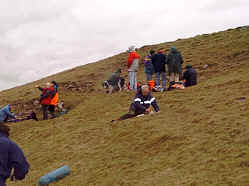
A few times a year they meet at so called "fieldmeetings" somewhere in England (Img.1). At these meetings they can exchange ideas and do some experiments. Four times a year they publish the CREG Journal with articles concerning cave electronics. One can say that the CREG and the CREG Journal are the worlds leading group and publication concerning cave related electronics.
Around 1995 the first new cave radio was published in the CREG Journal. It was a design by John Hey and consisted of a transceiver at 87 kHz and a loop antenna which transmitted the signals. So nothing new under the sun. It was the same system as the Molophone from ten years earlier. The most important change however was that the radio was very easy to build. Because of this other people started to build their own cave radio according to John's design. This of course created new ideas and new designs.
After an accident in the Gouffre Berger in France, where Nicola Dollimore from
England died, a fund was created to develop the ultimate cave radio. A group
of French cavers and radio amateurs started to look around to see what was built
at that moment.
They invited the Swiss and the English to discuss this ultimate cave radio.
They decided to use a radio based on John Hey's design and the antenna system
from the Swiss. This "earth current" antenna system uses two long
wires, coming from the transmitter, which are connected to the earth at the
ends. With this the signal coming from the transmitter is injected into the
earth, generating a current that flows in the earth from one wire to the other
wire.
The English also changed to the earth current system with spectacular results. Signals were many times stronger and therefore it was easier to set up the equipment because the vertical position between surface- and cave radio was less critical. They also noticed that the earth current signals could be received on the induction loop antenna. This meant that the current created a "virtual" loop in the earth that started to radiate magnetic fields.
In France Graham Naylor and his team finally designed and build the Systeme Nicola MK II.
At the same time there was the development of the radiolocation beacons. These beacons are used to find positions in a cave from the surface and make it possible to calculate the distance between transmitter and receiver.
Radiolocation beacons and how they work:
A transmitter transmits a very low frequency signal. The antenna, a magnetic
loop which is a coil of copper wires 50cm in diameter, is placed perfectly horizontal
on the cave floor. The magnetic waves will be transmitted as shown in Img.2
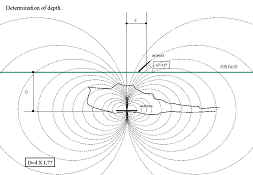
|
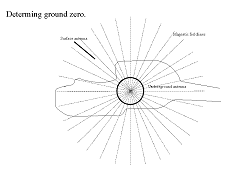
|
|
|
|
At the surface we use a VLF receiver. The receiving coil is held in his vertical
position and turned around his vertical axis (Img.3 ). At a specific
moment the received signal from the transmitter will disappear completely. The
coil is now pointing to the point under which the transmitter is placed. When
we do this from different places the point were the virtual direction lines
cross is ground zero.
When we keep now the receiver coil in an 45° angle from his horizontal position
and move the coil away from ground zero there will be a point were the signal
disappears again.
With the distance from this point to ground zero it is possible to calculate
the distance between the surface and the transmitter. There are also more accurate
methods to calculate the distance between the transmitter and receiver coils.
The practical usable distance depends on the design of the system. Some of them
reach a distance up to 200m.
Cave radios and how they work:
For cave radios things are a bit simpler. Like it was said before we don't use
loop antennas anymore but two wires. One side of the wires is connected to the
cave radio and the other side is connected to the earth (Img.4). The
better the earth connection, or the lower the resistance to the earth, the more
power can be injected into the earth. During transmission there will be a current
flowing from one wire to the other through the earth. But it appeared that this
current also generates a magnetic field that can be received with a loop antenna.
In the cave we use an identical transmitter with the same wires.
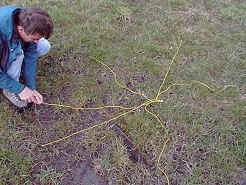
Img.4
The biggest advantage of this system is the much greater range and the freedom
of set up. When we are not working at the limits of the range of the two radios
they don't have to be placed right above each other.
The connection can be made in different ways. We can use earth spikes, which
are driven into the soil. Best is to use more than one earth spike at each side.
The more connections to the earth the lower the resistance. Another method,
which is developed by the French, is to use cattle fence wire. This wire is
spread out on the ground and covered with stones. The principle is that many
bad contacts makes one good contact. This method is used on bare rock like a
lapiaz. In the cave the fence wire can also be used. Just put the wire in a
river, a pool or in wet mud.
Under the right conditions communication over a distance of 500 to 600 m is
perfect. When the geology of the underground is taken into account, communications
over distances up to 1200m are possible.
The expedition cave radio.
The cave radios that are in use at this moment are made especially for cave
rescues. This means that they are very robust and simple to use. We wanted to
build a cave radio that was adapted to be used during caving expeditions.
When we are using the radios at their limits of range the underground and surface
radio have to be placed above each other. When the entrance of the cave and
the place of action in the cave (underground camp) are far from each other,
the surface radio will also be placed far from the entrance. In remote places
this means that someone has to be placed in the middle of nowhere to man the
surface radio. This is not practical of course. This is why Erwin has made a
system to solve this problem.
As a base we used John Hey's latest designed cave radio.
In the underground radio we included a radiolocation beacon. There is also a
"sign of life" beep. This is a short signal that is transmitted every
90 sec. to indicate at the surface that the underground radio is switched on
and working. To improve the autonomy there is the possibility to connect extra
exterior batteries.The whole radio is fitted into a watertight Peli box and
weighs with the interior batteries 2kg. (Img.5).
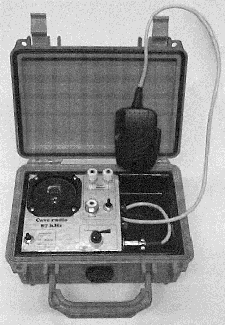
In the surface cave radio (Img.6) we have fitted some more add-ons.To
solve the problem of the distances at the surface between surface radio and
surface camp we have made the radio in a way it can work for weeks on his own.
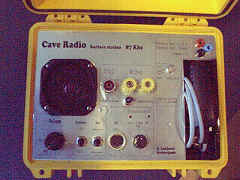
Img.6
So a complete underground station consists of: the cave radio,
a set of wires, the earth spikes and/or the fence wires. This fits in a small
tackle bag and weighs arround 2,5kg.
A complete surface station consists of: the cave radio, a set of wires, the
earth spikes or fence wires.Furthermore this can be completed by an extra battery,
a solarpanel and the electronics to connect the solarpanel to the battery.
The benefits of cave radios.
Like it is said before the English cave rescue organisations are using cave
radios for many years now, and with great success.
The first cave radio built by myself dates from 1995. In that period our club
had discovered a new cave, which has some passages that can be dangerous for
flooding. By using the radio to stay informed about the weather conditions we
should have been able to explore the rest of the cave.
The Nicola System is probably the break-through for the use of cave radios.
During the rescues in the Vittarelles cave and in the Tannes aux Crolleurs in
France the Nicolas were used extensively.
Graham Naylor has calculated during a rescue training in the Dents des Crolles
(France) that there can be a gain of time of around 5 to 8 hours. Especially
the mobility of the cave radios is a big advantage.
I think that the next application of cave radios is the use during expeditions. The cave radios can accomplish a permanent link between the cave and the surface. Messages can be passed immediately and in case of an accident precious time can be saved.
Cave radios will become standard equipment for big caving expeditions.
The only thing for the moment is that they are not commercially available. This
is still an obstruction for their break-through. On the other side this gives
to us, the home builders, the feeling to do some pioneering.
In the future the equipment will be smaller and lighter. Maybe the technology
will take a totally different direction.
We hope that our efforts are a contribution to this.
Everything we have designed will be made available on the internet.
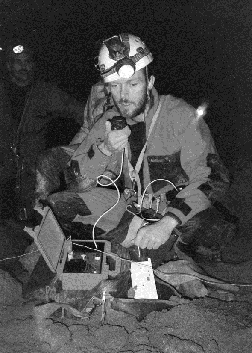
Underground test of the caveradio.
The CREG:
To end, a few words about the CREG.
Like it is said before the CREG groups people, spread all over the world, who
are busy with electronics for cavers and caving.
The CREG Journal is probably the most important and only periodical in the world
dedicated to cave related electronics. Likely, cave radio techniques would not
have been as far as they are now without the CREG.
These days most recent experiments are alternative caving lights. Here we may
expect revolutionary changes in the future. Other topics are electronic cave
surveying. Laser range finders, laser clinos and electronic compasses. It is
only a matter of time.